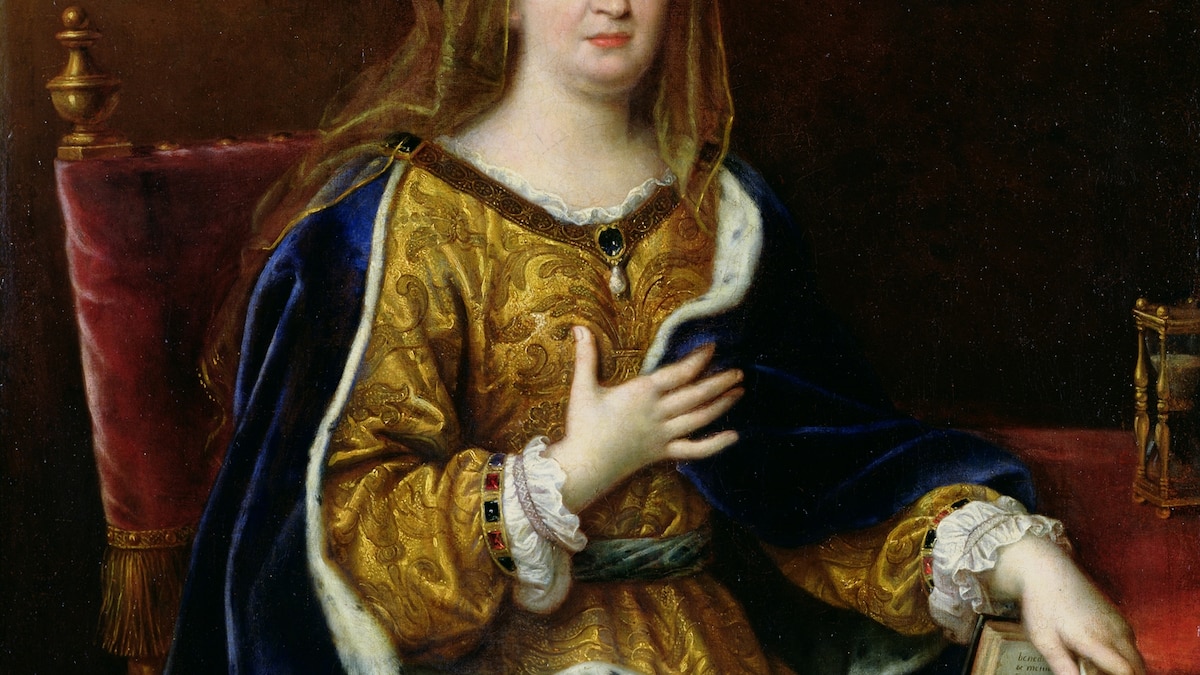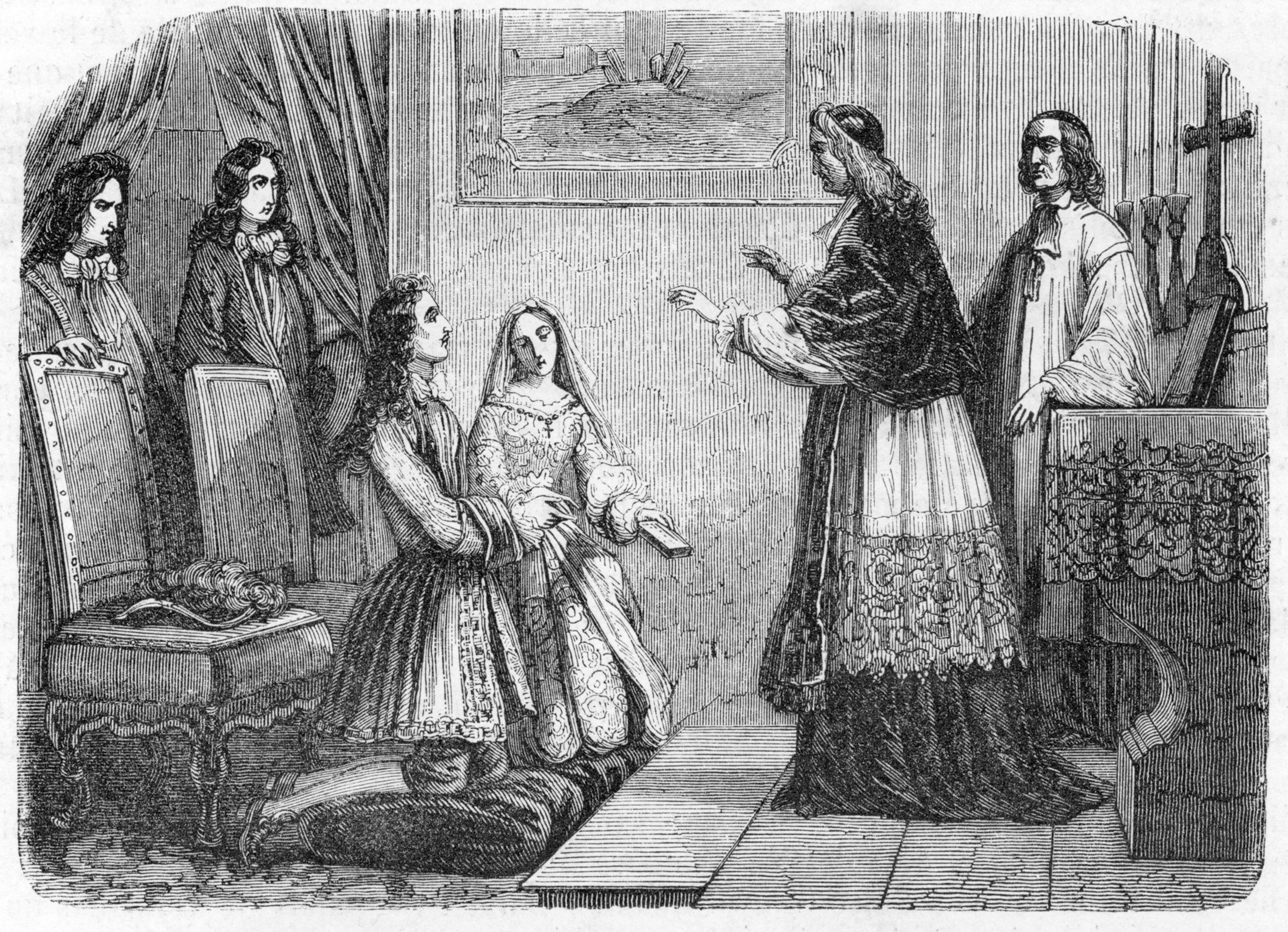Now Reading: A real life Cinderella or scheming social climber? The story behind Louis XIV’s secret wife.
-
01
A real life Cinderella or scheming social climber? The story behind Louis XIV’s secret wife.
A real life Cinderella or scheming social climber? The story behind Louis XIV’s secret wife.

In the autumn of 1683, in a candlelit chapel at the Palace of Versailles, a late-night marriage ceremony took place.
The groom was none other than the ruler of France, Louis XIV, 45, also known as the Sun King. His bride was the Marquise de Maintenon, 48, a woman of humble origins who had served as the governess to his children. Only the King’s confessor and the archbishop of Paris were present at the clandestine nuptials and the marriage was never officially registered.

Secret marriage of King Louis XIV (1638-1715) and Francoise d’Aubigne Marquise de Maintenon (Madame de Maintenon 1635-1719. Engraving from “” Louis XIV et son century” by Alexandre Dumas, 1851 Private collection
Photograph by The Holbarn Archive / Bridgeman Images
Unbeknownst to the Court of Versailles and the rest of the world, Madame de Maintenon became the uncrowned Queen of France.
Few figures of France’s Ancien Régime are as enigmatic and divisive as the Marquise de Maintenon. She has been portrayed as everything from a generous, real-life Cinderella to a cold, scheming social climber. Love her or loathe her, the extraordinary story of her rags-to-riches rise does seem to have been plucked from the pages of a fairytale.
Françoise d’Aubigné, as she was formerly known, was born in 1635 in a prison in Niort in western France where her father Constant was locked up for numerous crimes. She was the result of a union between the incarcerated man and the prison governor’s much younger daughter. Her grandfather Agrippa d’Aubigné was a renowned poet and respected member of the minor nobility, but unfortunately for Françoise, the younger d’Aubigné didn’t take after his father and instead spent his life drinking, gambling, and scamming his way around France.
Indeed, Agrippa d’Aubigné was so disappointed with his “wretch” of a son, that he disinherited him, unwittingly leaving Constant’s young wife and kids to their father’s whims, which included a perilous voyage across the Atlantic to the Dutch Antilles in a failed attempt to start a plantation two years after his release from prison. Constant then abandoned his family and returned to France where he died a short time later under ambiguous circumstances. With no money and Constant out of the picture, the remaining d’Aubignés also left the Caribbean. Back home, however, the family’s situation was so dire that 12-year-old Françoise resorted to begging for food on the streets of La Rochelle.
Instability followed Françoise into her adolescence, during which she briefly lived with a beloved Huguenot aunt and uncle at their estate and in the home of her godmother’s mom, Madame de Neuillant, who promptly shipped her off to an Ursuline convents in the hopes of converting the rebellious teenager to Catholicism. She resisted at first, but eventually embraced France’s dominant religion, helped along to some extent by a young nun, Sister Céleste, with whom she formed a close friendship. When Françoise lost her place in the convent because de Neuillant refused to pay the fees, the latter married her off to the writer Paul Scarron. More than 20 years her senior and badly deformed by rheumatoid arthritis, Scarron’s first meeting with the 16-year-old resulted in her bursting into tears. However, Françoise accepted his proposal anyway. Although considered strikingly beautiful, the tall, dark-eyed brunette was broke, an orphan, and lacking a dowry. Her only other option was to return to a convent.

A salon at Versailles in the time of Louis XIV, 1660
Photograph by Look and Learn / Bridgeman Images
The union would change the course of her life. What he lacked in looks, Scarron made up for in intelligence, wit, and social savvy. The host of a famed salon libertine in the French capital, Scarron welcomed a medley of literary luminaries, philosophers, and wealthy aristocrats into his home. His young bride quickly became a star of the Paris salon scene. In addition to her physical beauty–she was nicknamed la belle indienne because of her tan complexion–Françoise was also highly intelligent. Her stays with her aunt and uncle, and her stints in the convent provided her with an education, which she further polished by engaging with and closely studying the refined salon guests. Realizing she couldn’t compete with the stylish and privileged women in her midst, Françoise employed an unorthodox strategy for social success.
“Unable to perform à la mode, she played instead a tactical counterpoint, dressing with deliberate simplicity and disdaining even the plainer jewelry she might have worn,” writes Veronica Buckley in a biography on Maintenon.
This calculated image of modesty charmed the nobles, and soon Françoise–now Madame Scarron–developed a slick social acumen that even modern-day business moguls would envy. A talented conversationalist and an astute listener, she built relationships with the writers Racine and La Fontaine, as well as the legendary courtesan Ninon de Lenclos.
“She has an agreeable and marvelously sensible mind,” the aristocrat Madame de Sévigné wrote in a letter, in which she referred to the company of Françoise as “delicious.”
It was her dazzling social network that came to her aid upon the death of Paul Scarron, who left his 25-year-old widow with piles of debt. Her friends helped her secure a pension from the Queen Mother, but it was another high-level salon contact that would offer her an opportunity that would take her status to new heights.
A member of the high nobility, Madame Athénaïs de Montespan, 29, was King Louis XIV’s official mistress and needed a governess to discreetly raise the 31-year-old king’s illegitimate offspring. Françoise accepted, and Montespan and the king went on to have seven children together. Louis’ impression of the new governess was of an uptight prude, and he wrote her off as “unbearable.” But his opinion of Françoise softened over the years. He became charmed by the love she showered on his children–“It would be something to be loved by a woman like that,” Buckley quotes him as saying–and was impressed with her intelligence and calm, rational demeanor, which was a refreshing change from the high maintenance “La Montespan.”
A close friendship developed in the early 1670s when Françoise was in her late-30s. The bond between the monarch and the governess deepened after she relocated with the children from Paris to the palace at Saint-Germain-en-Laye after Louis, many believe at Françoise’s gentle prompting, decided to legitimize his progeny with Montespan. The two spent more and more time together, often deep in conversation, and Louis showed his appreciation by upping her salary and offering her generous monetary gifts.
Françoise used the money to purchase a Renaissance-style chateau in Maintenon, and Louis XIV gave her the title of Marquise de Maintenon. Historians believe that a romantic relationship started between the king and Madame de Maintenon around 1680. Some speculate that he had grown tired of Montespan and her histrionics and was finally ready to settle down with someone stable and serious. The pious Maintenon fit the bill–the king’s nickname for her was “Your Steadiness”–and a deep friendship already existed between the two. The middle-aged Louis had also endured illnesses in recent years and was beginning to feel the weight of his mortality.
“He was a believing man,” Buckley says. “He was afraid of dying and going to hell.”
You May Also Like
Indeed, during this time, changes were noticed in the ruler and at Court. The debauched parties ceased, and Montespan, much to her chagrin, was officially cast aside in favor of her onetime friend. At Maintenon’s behest, the incorrigible womanizer also began to behave more kindly to his long-neglected wife, Queen Maria-Theresa, in her final years.
It was several months after the queen’s death in 1683 that France’s king and Maintenon were wed at the intimate nighttime ceremony. Because of her lower social status, the union was kept secret, although many courtiers suspected the truth. After the marriage, Louis abandoned his lifelong philandering in favor of a more wholesome existence, a change historians attribute to the influence of his devout wife.
Louis may have been besotted with her, but not everyone at Court was fond of the former commoner whose apartments at Versailles were adjacent to the king’s. “Old witch,” “old whore,” and “mouse dropping,” are but a few of insults that the French ruler’s sister-in-law, Princess Palatine, lobbed at his second wife in letters to relatives. Meanwhile,in his memoirs, the Duc de Saint-Simon depicts Madame de Maintenon as a duplicitous, power-hungry hypocrite.
“She was very beautiful, she was very intelligent, she had a natural grace and a natural authority about her, and yet she came from nothing and people don’t like that,” Buckley says. “Particularly in a situation where rank is everything, there was a strong attitude of ‘who does she think she is?’”
Christine Adams, a professor at St. Mary’s College of Maryland and co-author of a book on French royal mistresses says that 19th-century historians also unfairly villainized Maintenon, blaming her, for instance, for the king’s decision to revoke the Edict of Nantes, which subjected the country’s Huguenots to renewed persecution and violence.
“The historiography about her is very split,” she says, acknowledging that, like most members of the Court of Versailles, the uncrowned queen had a ruthless side. “I think we have all been influenced by this sort of black legend about her.”
Maintenance’s political influence at Court also remains a subject of debate among historians.
“Louis XIV did not want Madame de Maintenon in his government, he wanted her in his bed,” quipped Jean Cordelier in his 1955 biography. But many modern scholars disagree, asserting that she played a pivotal role in the Sun King’s government.
In his book, Queen of Versailles: Madame De Maintenon, First Lady of Louis XIV’s France, Mark Bryant argues that at a certain point Maintenon’s influence at Versailles rivaled that of ministers, especially during the War of the Spanish Succession when in addition to “participating in conciliar discussions, she also received and named ambassadors, and helped modify government policies.”
“She clearly had enormous influence as a political advisor; their councils met in her chambers,” Adams says. “Someone who is the most influential conduit to the king’s favor is somebody with political influence.”
It was the boarding school she founded outside of Versailles in Saint-Cyr, however, that Maintenon is believed to have been particularly passionate about. Students at the Maison Royale de Saint-Louis comprised impoverished girls from noble families–just as she herself had once been–who were given an elite education and furnished with dowries. Upon the death of Louis XIV in 1715, the elderly Maintenon retired to the school, where she continued to receive illustrious visitors, including Peter the Great. She died four years after the king at the age of 83 and was buried in the school’s chapel.
Less than an hour by train from Paris, the Château de Maintenon is surrounded by stunning flower gardens originally designed by André Le Nôtre–the celebrated landscape architect behind the gardens at the Palace of Versailles. Some 15,000 tulips bloom each spring, and all year long visitors can tour the interior and admire various personal items, including a library filled with her favorite volumes. Pierre Mignard’s large oil painting of the late marquise also hangs in the chateau. It depicts a plump, middle-aged woman clad in a gold brocade dress and a royal-blue cape. She holds an open book in her left hand and seems to be gazing pensively at spectators.
Near the end of her life, Madame de Maintenon burned thousands of her personal letters, including much of her correspondence with Louis XIV. Other letters were lost in the late 19th century when a fire broke out at the Louvre.
“My life…has been a miracle!” she reportedly said to a friend in her later years.
However, the destruction of her most intimate writings ensures that more than 300 years after her death, France’s complicated secret queen remains, above all things, an enigma.
























